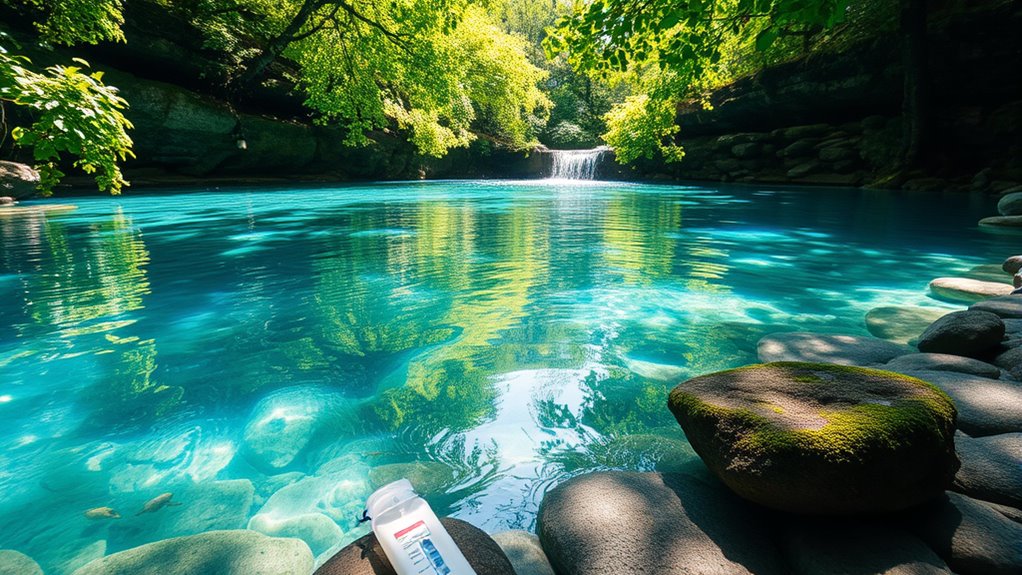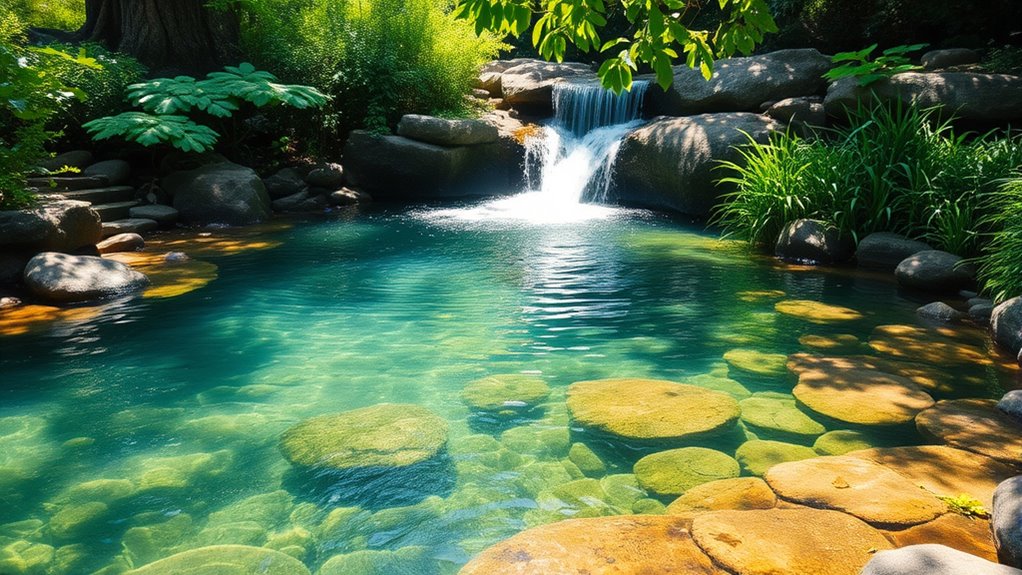To maintain water quality in your natural plunge pool or pond, focus on supporting biological filtration with aquatic plants like water lilies and submerged vegetation, which absorb excess nutrients and reduce algae. Regularly remove debris and organic waste, ensure proper circulation with waterfalls or fountains, and monitor water parameters such as pH and nutrients. Using natural treatments like beneficial bacteria helps keep algae in check. Keep exploring for more tips on keeping your pond healthy and clear.
Key Takeaways
- Incorporate aquatic plants like water lilies to absorb excess nutrients and improve water clarity.
- Install circulation features such as waterfalls or fountains to promote oxygen flow and prevent stagnation.
- Regularly remove debris, fallen leaves, and organic waste to reduce nutrient buildup and algae growth.
- Use beneficial bacteria treatments and natural remedies like barley straw to support organic matter breakdown.
- Monitor water parameters regularly and adjust plant density and circulation to maintain balanced, healthy water quality.

Maintaining good water quality in plunge pools and ponds is essential for safety and enjoyment. When your goal is to keep the water clean and clear naturally, understanding how natural filtration works is key. Natural filtration relies on biological processes that use plants, beneficial bacteria, and other natural elements to break down impurities and keep the water balanced. By designing your pond or plunge pool with appropriate filtration methods, you can minimize the need for chemical treatments and create a healthier environment. Incorporate plants such as water lilies or submerged vegetation, which act as natural filters by absorbing excess nutrients, reducing cloudiness, and keeping algae growth in check. These plants also provide oxygen, supporting beneficial bacteria that naturally degrade organic waste, further improving water clarity and quality.
Algae control is another vital aspect of maintaining water quality. Algae can quickly overrun your pond or plunge pool if not managed properly, leading to green, murky water and potential health hazards. To control algae naturally, you should limit nutrient buildup by avoiding overfeeding aquatic life and removing debris that can serve as nutrients for algae. Installing beneficial bacteria treatments can also promote the breakdown of organic matter and suppress algae growth without resorting to harsh chemicals. Regularly inspecting your water and removing algae manually helps prevent it from spreading and becoming a bigger problem. Ensuring proper circulation with a gentle waterfall or fountain encourages oxygen flow and discourages stagnant areas where algae tend to thrive. Additionally, using natural filtration systems can enhance water quality by supporting biological processes and reducing maintenance efforts.
Consistent monitoring is vital in maintaining water quality. Test your water regularly for pH, ammonia, and nitrate levels to catch imbalances early. If you notice a spike in algae, adjust your natural filtration system by adding more aquatic plants or increasing circulation. Keep the pond or plunge pool’s edges clean and remove any fallen leaves or organic waste that can decompose and fuel algae growth. Using natural remedies like barley straw or beneficial bacteria can also help control algae without introducing chemicals. These methods work synergistically to keep your water clear and healthy, providing a safe environment for swimming or relaxing.
Frequently Asked Questions
How Often Should I Test Water Ph Levels?
You should test your water pH levels at least once a week to guarantee proper pH balancing. Regular water testing helps you catch any shifts in pH early, preventing problems like algae growth or irritation. If you notice changes in water clarity or smell, test more frequently. Keeping a consistent testing schedule allows you to maintain healthy water conditions and enjoy your natural plunge pool or pond safely.
What Natural Methods Can Improve Water Clarity?
You can improve water clarity naturally by using biological filtration, which encourages beneficial bacteria to break down organic waste, and mineral clarifiers that help settle particles. Regularly add aquatic plants, like lilies or reeds, to absorb excess nutrients and shade the water, reducing algae growth. Keep the pond well-aerated and remove debris frequently. These methods work together to keep your water clear without chemicals, creating a healthier pond environment.
How Can I Prevent Algae Growth Naturally?
To prevent algae growth naturally, you should regularly remove organic debris and limit nutrient buildup. Use natural deterrents like barley straw or copper-based solutions, which inhibit algae development. Guarantee proper water circulation and shade the pond to reduce sunlight exposure. Maintaining balanced aquatic plants also helps outcompete algae for nutrients. These methods work together to keep algae at bay without chemicals, supporting a healthy, clear pond environment.
Are There Eco-Friendly Water Treatment Options?
Yes, eco-friendly water treatment options include biological filtration and mineral balancing. You can use biological filters that naturally break down organic matter, reducing algae growth and maintaining water clarity. Additionally, balancing minerals like copper or zinc in small amounts can inhibit algae without harsh chemicals. These methods work together to keep your water clean and healthy, supporting a balanced ecosystem while being gentle on the environment.
What Are Signs of Water Contamination to Watch For?
Your water might be contaminated if you notice a foul odor or thick surface scum that seems to take over like an unwanted invasion. These signs point to bacterial growth and algae blooms, which threaten water quality. Keep an eye out for murky water and strange colors too. If you spot any of these, it’s time to take action to restore balance and keep your pond healthy and inviting.
Conclusion
To keep your plunge pool or pond pristine, regularly test water parameters and remove debris. Use natural methods like planting aquatic vegetation to filter pollutants and prevent algae blooms. Remember, even in these tranquil waters, neglect can turn your oasis into a swamp reminiscent of the swamps of Sherwood Forest. Stay vigilant, and your pond will remain a revitalizing retreat for years to come—just as the ancients kept their sacred waters pure and revered.









